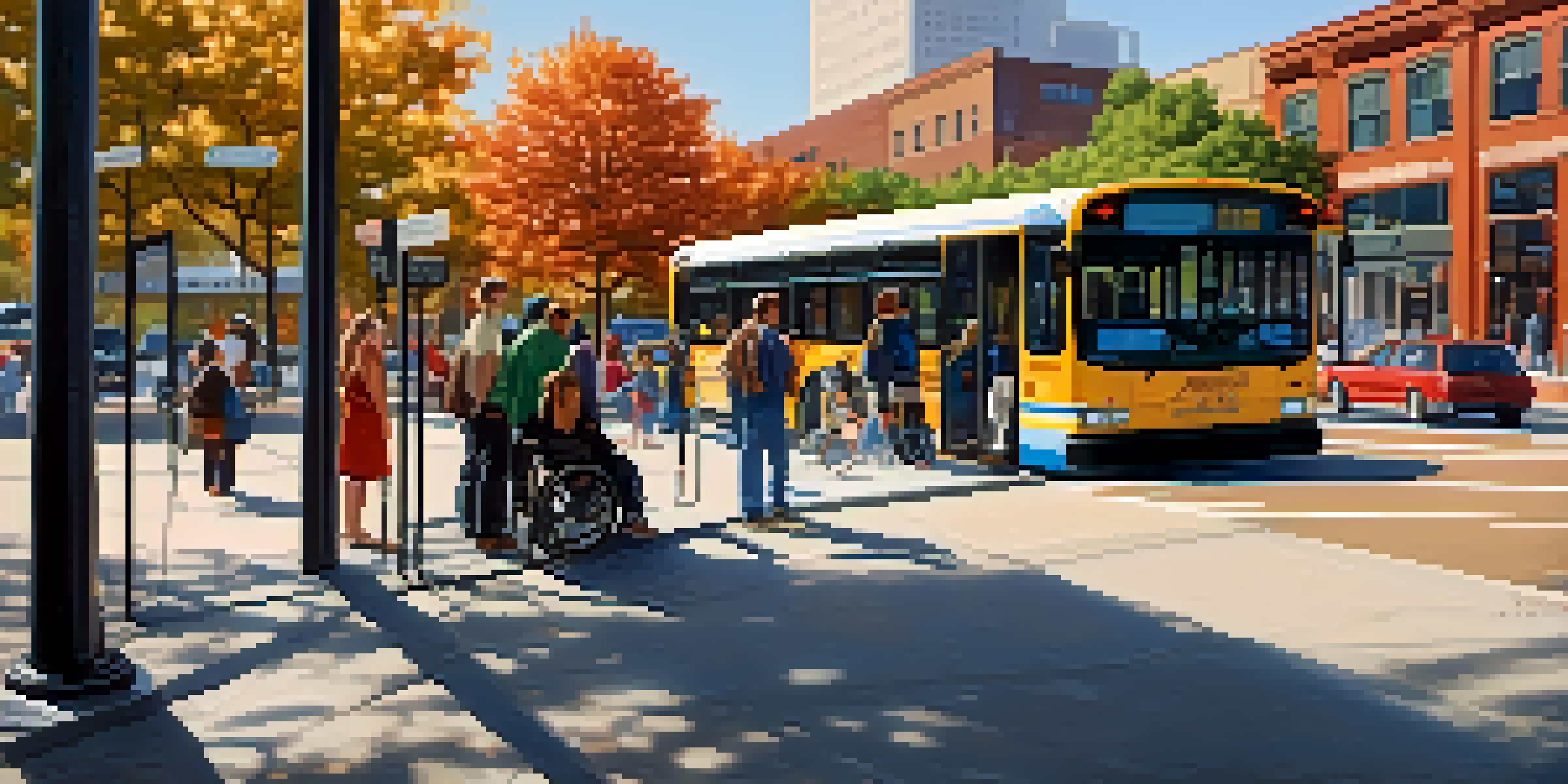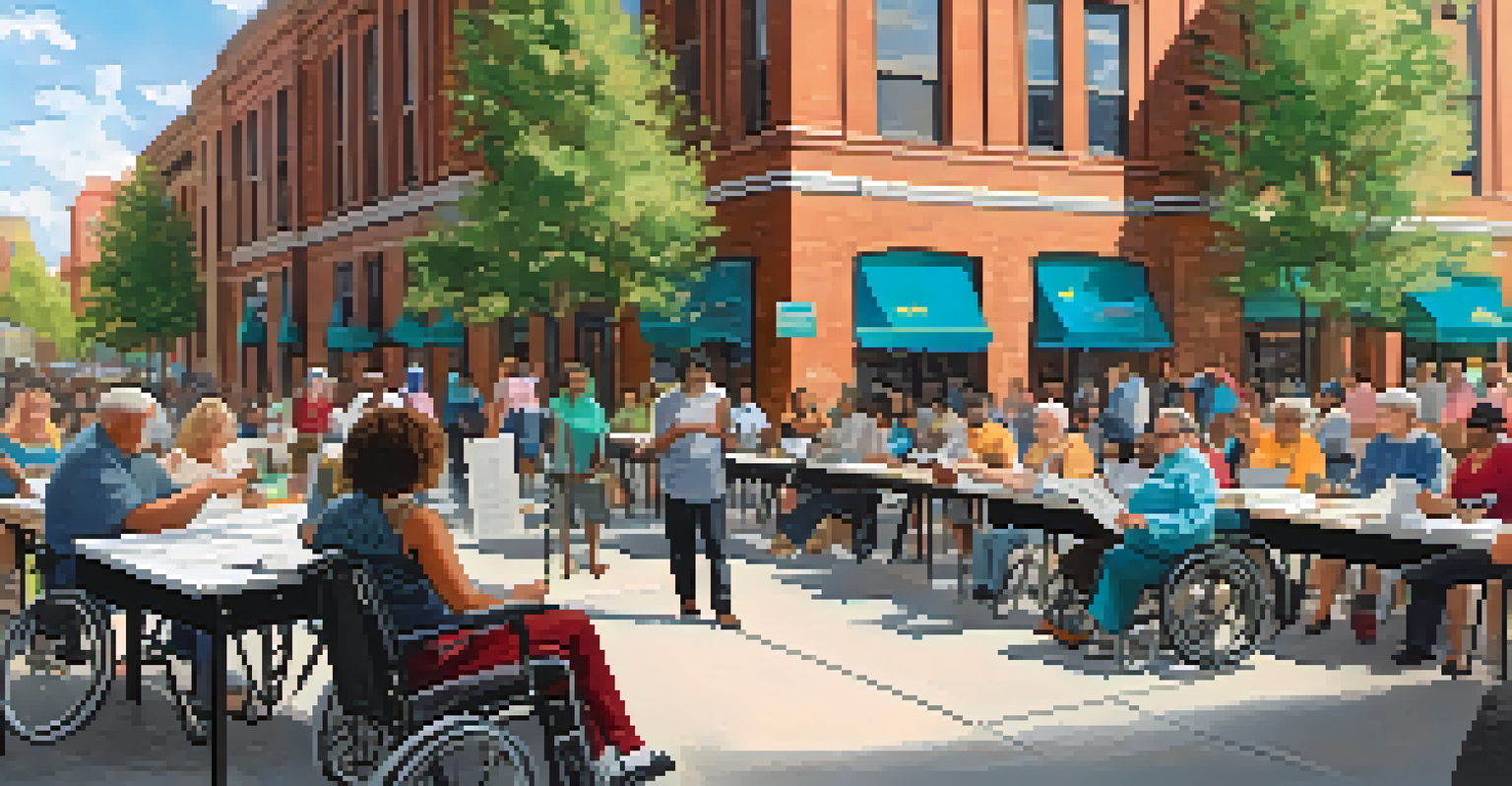Accessibility in St. Louis Transportation: A Comprehensive Review

Overview of Transportation Accessibility in St. Louis
Transportation accessibility in St. Louis is vital for ensuring that everyone can navigate the city, regardless of their physical abilities. It encompasses various modes of transport, including buses, trains, and taxis, all designed to accommodate individuals with disabilities. Understanding the current state of accessibility helps identify areas for improvement and highlights successes.
Accessibility is not a privilege, but a right that must be ensured for everyone.
The city has made strides in enhancing accessibility, especially with the implementation of the Americans with Disabilities Act (ADA) guidelines. This federal legislation mandates that public transportation systems be accessible to people with disabilities, promoting equity in mobility. However, the reality can vary, and continuous assessments are necessary to ensure compliance and effectiveness.
In this review, we will delve into specific aspects of St. Louis's transportation system, examining the effectiveness of measures in place and identifying potential gaps. By doing so, we can better appreciate how accessible transportation directly impacts the day-to-day lives of residents and visitors alike.
Public Transit: Buses and Light Rail Accessibility
St. Louis's public transit system, including buses and the MetroLink light rail, plays a crucial role in providing accessible transportation. Many buses are equipped with features like low floors, ramps, and designated spaces for wheelchairs, making boarding easier for all passengers. Additionally, the MetroLink stations have elevators and tactile paving for visually impaired individuals.

Despite these advancements, challenges remain. Some bus stops may lack proper accessibility features, such as curb cuts or adequate signage, particularly in older neighborhoods. Addressing these inconsistencies is essential to ensure that the entire public transit system is genuinely accessible to everyone.
St. Louis Transportation Accessibility
Transportation accessibility in St. Louis is essential for all residents, promoting mobility and equity.
Moreover, ongoing training for transit staff is vital to equip them with the skills needed to assist passengers with disabilities effectively. By fostering a culture of understanding and support among employees, St. Louis can provide a more welcoming environment for all riders.
Accessibility Features in Taxis and Rideshares
Taxis and rideshare services like Uber and Lyft are increasingly vital for those seeking accessible transportation options in St. Louis. Many taxi companies have begun to incorporate accessible vehicles into their fleets, ensuring that individuals with mobility challenges can find suitable rides. Rideshare apps also offer features that allow users to request accessible vehicles easily.
The greatest disability is the inability to see beyond the barriers and create a more inclusive world.
However, the availability of these accessible options can be inconsistent, especially during peak times or in less populated areas. Riders may find themselves waiting longer or being unable to secure a ride that meets their needs. This highlights the importance of better coordination between taxi services and rideshare companies to improve accessibility.
Furthermore, raising awareness among drivers about the importance of accommodating passengers with disabilities is crucial. Training programs that emphasize customer service and proper vehicle support can significantly enhance the overall experience for all riders.
Pedestrian Infrastructure and Accessibility
An essential component of transportation accessibility is the infrastructure for pedestrians in St. Louis. Sidewalks, crosswalks, and pedestrian signals must be designed to accommodate individuals with disabilities. Features like curb ramps, wide pathways, and audible signals ensure safety and convenience for all pedestrians.
Unfortunately, many areas still have gaps in pedestrian infrastructure, making it challenging for those with mobility issues to navigate the city. Cracked sidewalks, poorly marked crossings, and missing ramps can create significant barriers. Addressing these issues is not just about compliance; it's about fostering an inclusive community.
Public Transit Improvements Needed
While public transit features have improved, there are still gaps in accessibility that require ongoing attention.
Community input and feedback can play a valuable role in improving pedestrian infrastructure. Engaging residents in discussions about their experiences and needs can guide city planners in making informed decisions that enhance accessibility for everyone.
Transportation for People with Cognitive Disabilities
Accessibility in transportation must also consider individuals with cognitive disabilities, who may require additional support in navigating public transit. Clear signage, straightforward announcements, and staff trained in assisting these individuals are vital components of an inclusive transport system. Understanding diverse needs is key to fostering a truly accessible environment.
St. Louis has made progress in this area, with several initiatives aimed at improving communication and support for individuals with cognitive challenges. Programs that provide travel training can empower these individuals to use public transit confidently, reducing dependence on caregivers and promoting independence.
However, ongoing efforts are necessary to ensure that these programs reach those who need them most. Collaborating with local organizations that advocate for individuals with cognitive disabilities will help ensure that their voices are heard in the planning and implementation of accessible transportation solutions.
Community Feedback and Its Role in Accessibility Improvements
Community feedback is a powerful tool in shaping transportation accessibility initiatives in St. Louis. Residents with disabilities often have firsthand experience with the transit system, offering valuable insights into what works and what needs improvement. Engaging the community in discussions about their experiences can help city planners make informed decisions.
Public forums, surveys, and partnerships with advocacy groups are effective ways to gather this feedback. By actively listening to the needs of residents, St. Louis can prioritize projects that will have the most significant impact on enhancing accessibility. This collaborative approach fosters a sense of ownership and community involvement.
Community Feedback Drives Change
Engaging the community in feedback processes is crucial for shaping effective accessibility initiatives in transportation.
Moreover, showcasing success stories can inspire further improvements. When individuals see the positive changes made based on their feedback, it encourages continued participation and advocacy for a more accessible transportation system.
Future Initiatives for Enhanced Accessibility
Looking ahead, St. Louis has the opportunity to implement several initiatives aimed at further enhancing transportation accessibility. Investing in technology, such as real-time transit apps that provide updates on accessible routes and services, can significantly improve the user experience. These advancements not only benefit individuals with disabilities but also enhance the overall efficiency of the transit system.
Moreover, expanding partnerships with local organizations can lead to innovative solutions tailored to the community's needs. Collaborating with disability advocacy groups can ensure that new programs and services are responsive and effective. This approach can also help to secure funding and resources for ongoing projects.

Finally, setting measurable goals and timelines for accessibility improvements can help track progress and hold stakeholders accountable. By committing to continuous improvement, St. Louis can create a transportation system that is inclusive, equitable, and accessible for all.
Conclusion: The Importance of Accessible Transportation
In conclusion, accessible transportation in St. Louis is a critical factor in promoting inclusivity and equity for all residents. By examining the various modes of transport, infrastructure, and community input, we can see both the progress made and the work that remains. The journey toward comprehensive accessibility is ongoing and requires collaboration among government, organizations, and the community.
Enhancing transportation accessibility not only benefits individuals with disabilities but also enriches the entire community by fostering a more connected and engaged populace. When everyone can move freely and confidently, St. Louis becomes a more vibrant and welcoming city for all.
As we move forward, commitment to continuous improvement and community involvement will be essential in shaping a transportation system that truly serves everyone. Embracing the challenge of accessibility is not just a responsibility but an opportunity to build a brighter, more inclusive future.